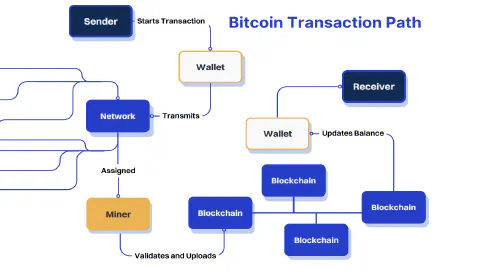Tracing Bitcoin Transactions: A Complete Guide
Salomon Kisters
Nov 30, 2022This post may contain affiliate links. If you use these links to buy something we may earn a commission. Thanks!
Many people believe that Bitcoin is anonymous. However, this is not the case.
Bitcoin, contrary to popular belief, is traceable. While your identity is not directly linked to your Bitcoin address, all transactions are public and recorded on the blockchain. So, while your name is not attached to your address, your address is attached to your transaction history.
In this guide, we will show you how to trace Bitcoin transactions using a blockchain explorer. A blockchain explorer is a tool that allows you to view all of the blocks on the blockchain and see the addresses and transactions related to them.
What is a Bitcoin Transaction, and How Does it Work?
A Bitcoin transaction is a digital exchange of value between two parties. This can be accomplished either through an online exchange or directly between individuals. When a transaction is made, it is recorded in a public ledger called the blockchain.
This ensures that the transaction is secure and cannot be tampered with. Bitcoin transactions are fast and efficient, and they can be made without the need for a third party, such as a bank or a financial institution.
The sender in a transaction must first choose how many Bitcoins they want to send. They will then enter the recipient’s address into the ’to’ field. The sender can also add a message to the transaction, which will be visible to the recipient. Once the sender has chosen the amount and entered the recipient’s address, they can hit ‘send.’
The transaction will then be broadcast to the whole network, where it will be verified by miners. Once it has been verified, it will be added to the blockchain, and the recipient will receive their Bitcoins. Bitcoin transactions are typically confirmed within 10 minutes.
In essence, transactions using Bitcoin are efficient and safe and can be completed without the involvement of a third party or central authority.
What is a Blockchain Explorer?
A blockchain explorer is a software program that gives users the ability to view the blocks that are contained on a blockchain, as well as the addresses and transactions that are connected to those blocks. One way to think of it is as a search engine tailored specifically for the blockchain.
Blockchain is one of the dozens of explorers that are currently available for tracing Bitcoin transactions. However, for the purpose of this guide, we will be covering only Blockchain, which is one of the most well-known blockchain explorers found today, and it features an intuitive user interface that makes it simple to locate the information that you require.
How to Trace Bitcoin Transactions
Now that we know what a blockchain explorer is, let’s take a closer look at how to use one to trace Bitcoin transactions on blockchain.
- The first step is to visit blockchair.com and enter the Bitcoin address that you want to trace into the search bar.
- Once you have done this, hit enter, and you will be taken to a page that contains all of the information related to that address.
- On this page, you will be able to see all transactions made from that particular address, as well as the addresses that it has been sent to.
- You can also see the block height at which each transaction was made, as well as the time and date. This information can be useful in tracking down a specific transaction or identifying patterns in spending behavior.
What is a Bitcoin Taint Analysis?
Taint analysis is a way of tracing crypto transactions to see where they came from and where they’ve been. This can be useful in tracing when someone is trying to launder money or hide the source of their funds.
Taint analysis works by looking at how addresses are connected. When someone sends Bitcoin to another person, they’re actually sending it to that person’s Bitcoin address. That address is then recorded on the blockchain, along with the addresses that it was sent from.
By studying these arrangements, it’s possible to see where a particular Bitcoin came from and where it’s been. This can be helpful in solving cases of fraud or money laundering, as well as in tracking down criminals and hackers.
Taint analysis is not the only or even the best solution out there, though. In some cases, it may be possible for miscreants to hide the origins of the funds by using multiple addresses or by mixing their Bitcoins with others. However, taint analysis can still be a useful tool in many cases.
How Taint Analysis is Used
Taint analysis is most commonly used by law enforcement agencies and financial institutions. In the case of law enforcement, taint analysis can be used to track down criminals who are using crypto to launder money or finance illegal activities. Financial institutions can use taint analysis to help prevent fraud and money laundering.
The Benefits of Tracing Bitcoin Transactions
The Bitcoin blockchain is a public ledger that records all transactions involving Bitcoin. It is possible to trace the movement of funds and determine how they are being used by tracking down these transactions in order to follow the trail of money. This can be useful in spotting potentially illegal activities like gambling or money laundering.
The ability to track transactions can also be beneficial for accounting and tax purposes. It is possible to compute capital gains and losses on investments if one is aware of where the funds are going and how they are being used. When it comes time to file taxes, having this information on hand can prove to be extremely helpful.
Ultimately, tracing criminals through their Bitcoin transactions might be useful to law enforcement organizations. Investigators are frequently able to track down the individuals involved in illicit activities by following the money trail. After gathering this information, one can then use it to bring the perpetrators to justice.
The Challenges of Tracing Bitcoin Transactions
Although Bitcoin is frequently appreciated for its anonymity, the fact of the matter is that it is still possible to trace transactions, and in some cases, doing so is even quite simple. This might be useful in two ways: firstly, by putting a damper on the plans of those who wish to utilize crypto for illegal reasons; and secondly, it serves as a useful tool for law enforcement authorities who are attempting to locate criminals.
Bitcoin transactions can be traced in a few different ways, and the one that ends up being employed is often determined by the user’s desired level of anonymity. There are a few possible approaches here.
Examining the public database of all transactions, which is referred to as the blockchain, is the simplest and most basic method. This will display each and every transaction that has ever taken place, but it will not expose the individuals who were behind those transactions.
Authorities may also turn to specialized software to study the blockchain and search for repeating patterns, yet another useful technique for tracking down the origins of suspicious transactions.
Tips for Staying Anonymous When Using Bitcoins
Don’t Reuse Addresses
You should create a new address each time you are paid in Bitcoins and use that address only for that particular transaction. This makes it more difficult for other people to link your payments together and helps prevent anyone from tracing down your activities.
Don’t Use Your Real Name
When creating a wallet, make sure to use a pseudonym instead of your real name. There are a number of ways to do this, such as using a fake name or using an online wallet service that doesn’t require personal information.
Be Careful with Online Wallets
If you are going to use an online wallet service, you need to be sure that you only select a trustworthy platform that has adequate safety procedures in place. It is best to avoid keeping a significant amount of cryptocurrency in an online wallet and instead withdraw them to a secure offline wallet at regular intervals.
Final thoughts
In the early days, hackers found the anonymity offered by Bitcoin as an opportunity to engage in criminal activities or hide illicit proceeds. However, Bitcoin is not truly anonymous, and this makes it possible for law enforcers to map activities on the Bitcoin blockchain for suspicious goings-on.
What is more, it is not as complicated to track Bitcoin transactions as many people might think. As long as you have access to a blockchain explorer, you will be able to get your hands on the information regarding any transaction that has ever taken place. The most commonly used and reliable block explorer and search engine for cryptocurrency transactions is blockchair.com, but there are other software and tools available as well.
On the other hand, if you are concerned about your own privacy, you can take certain steps to prevent others from checking or tracing your transactions on the blockchain. The Bitcoin blockchain maintains the full history of all transactions. They are only truly anonymous if you use a temporary wallet and destroy it after making a purchase.
Every time you get a new payment in Bitcoin, you should use a fresh address. Furthermore, you can utilize numerous wallets for various uses. By doing this, you can isolate every transaction you make so that it is impossible to link them all together.
While blockchain explorers are not able to reveal the identities behind the Bitcoin wallets, you should still be careful while handling online wallets and take every possible measure to safeguard your fund
Stay informed with the latest insights in Crypto, Blockchain, and Cyber-Security! Subscribe to our newsletter now to receive exclusive updates, expert analyses, and current developments directly to your inbox. Don't miss the opportunity to expand your knowledge and stay up-to-date.
Love what you're reading? Subscribe for top stories in Crypto, Blockchain, and Cyber-Security. Stay informed with exclusive updates.
Please note that the Content may have been generated with the Help of AI. The editorial content of OriginStamp AG does not constitute a recommendation for investment or purchase advice. In principle, an investment can also lead to a total loss. Therefore, please seek advice before making an investment decision.

How to Create a Bitcoin Blockchain Address: A Step-by-Step Guide
Discover the process of generating a Bitcoin blockchain address through our detailed step-by-step tutorial. Get started with cryptocurrency now!

What Is Bitcoin and What Is It Used For?
Bitcoin is a digital currency. What else is it used for?

DeFi vs. Bitcoin: Exploring Key Differences and Unique Benefits
Understand the key differences between DeFi (decentralized finance) and Bitcoin, exploring their unique benefits and how blockchain technology enables financial freedom.
Protect your documents
Your gateway to unforgeable data. Imprint the authenticity of your information with our blockchain timestamp